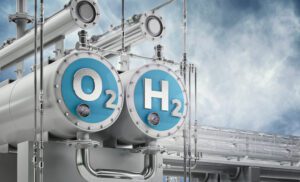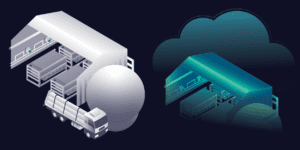The rapidly increasing demand for clean energy sources makes hydrogen a key element in the energy transition. Its ability to store and transport energy in large quantities makes it particularly attractive to industries looking for sustainable alternatives to fossil fuels. The shift to green hydrogen produced using renewable energy sources is an important step toward the decarbonization of various sectors, including transportation, industry and power generation. As a result, companies from a wide range of sectors outside the process industry are also becoming part of the hydrogen economy and are exploring hydrogen production.
Integrating the digital twin into hydrogen production opens up new opportunities when it comes to increasing efficiency and reducing costs — thus helping to ramp up hydrogen production in the face of high production costs. By using simulation models that replicate real plant operation, engineers and operators can optimize plant designs before physical components are built or modified. This approach makes it possible to identify and correct potential problems at an early stage, resulting in shorter development times and reduced costs. For the construction and operation of digital twins, however, it is imperative that the automation technology and industrial software are optimally coordinated.

Integrating the digital twin into hydrogen production opens up new opportunities when it comes to increasing efficiency and reducing costs — thus helping to ramp up hydrogen production in the face of high production costs (Photo credit: Siemens)
Standardization is crucial for modular systems
Unlike the processes that have been established for decades to produce mostly gray hydrogen via steam-methane reforming, the new technologies for producing green hydrogen are typically modular greenfield plants that consist of different package units. The resulting challenge is that each module has its own manufacturer-specific logic, programming and operation. In addition to the transmission protocols, the alarms and messages generated by the skids must also be correctly integrated into the control system. The same applies to the visualization of all control parameters. To ensure seamless interoperability of these different systems, standardization is the key to an open and flexible automation concept. Only on this basis can digital twins achieve their full potential.
A digital twin for the process industry is a virtual representation of the current and future physical reality, for example of a product, a production process, a plant, or even just a small sensor or pump, including its behavior and health status. It brings together data from all lifecycle phases and from all functions and levels, helping to understand, manage and predict the performance of the relevant components, and thus providing the basis for informed, data-driven decisions. The first step toward digital twins in hydrogen production is the design process for greenfield plants. To determine optimal process designs for a plant, simulations are run using process modeling software that can capture in-depth process knowledge in mathematical models that describe the physics and chemistry of the process flows.
Process simulation for modular systems
To illustrate and refine the process engineering concept in the next step, the previously collected process data are used for the process flow diagram (PFD), after which the more detailed piping and instrumentation diagrams (P&IDs) are created. Common plant components represented by P&IDs include tanks, pipes, valves and pumps. P&IDs also show how the process is controlled with typical automation elements, such as sensors and actuators. Engineering tools can help to create a digital twin for various plant engineering disciplines, such as process engineering, electrical engineering, systems engineering and piping and automation.
The entire automation of the plant must then be designed and engineered (the detailed engineering phase). This includes development of circuit diagrams, wiring and the distributed control system (DCS). The corresponding DCS hardware, such as remote IOs or controllers, must be placed, wired and configured in the field. The same holds true for the DCS software that needs to be designed and implemented. After DCS engineering, the critical phase of acceptance testing and commissioning begins. Some software packages can even make it possible to simulate the DCS behavior for virtual commissioning while the real plant is still under construction.
Significant increase in efficiency, faster time to market
By reusing the data from the process control system, process-modeling platforms and other engineering-design tools, the entire system behavior can be simulated prior to commissioning. The combination of these applications also ensures that the data of the digital twins are always up to date. If a 3D model of a plant is also available, this can often be used to train operating personnel at an early stage using virtual reality. This approach also makes it easier to achieve a low-disruption operating phase. To accomplish this, it is essential to enrich plant and operating data as well as documentation with both real-time and historical data.
As a result, digital twins reduce the time and effort required for on-site commissioning to a minimum, minimize errors, and can cut the project costs of a plant by around 15% — while at the same time decreasing the commissioning time by as much as 30%. By combining advanced engineering tools, it is possible to ensure that the digital twin is always current by continually updating the data. In engineering, automation and simulation, plant productivity and performance are optimized through the use of predictive models that are an accurate reflection of the actual plant.
Special requirements for electrolyzers
Electrolyzers are the core component of a green hydrogen plant. Their capacity cannot be scaled at will. Instead, multiple electrolyzers are operated in parallel by numbering up to increase the output of a plant. Once you have a digital twin of the electrolyzers, you can easily design a hydrogen plant by using copy-and-paste or drag-and-drop functionality. In the future, this approach can be used to copy and replicate entire H2 plants. This digital hydrogen plant forms the foundation for scaling up the electrolysis business (Figure 2). The above-mentioned simulation models will then run in the background in parallel with plant operation and detect any deviations from optimum operation. This ultimately makes it possible to find the most efficient and material-friendly operating modes for hydrogen plants.

FIGURE 2. A digital twin of an electrolyzer forms the basis for scaling up an entire green-hydrogen enterprise (photo credit: Siemens)
In addition, the digital twin facilitates the integration of hydrogen production plants into existing energy systems. By accurately simulating plant operation, operators can better understand how their plants will respond to a fluctuating energy supply from renewable sources and how best to integrate them into the broader energy grid. This capability is critical to maximizing the role of hydrogen as an energy-storage medium and increasing the flexibility of the energy system as a whole. Weather forecasts can also be fed into simulation models of plants, allowing operators to know at an earlier stage how much electricity they need to buy from the market for their plant. This in turn saves costs.
The entire architecture of the digital twin is designed for flexibility. This allows plant operators to set their own priorities, for example, in terms of information latency, infrastructure and provision costs, digital business model, and the level of information security required. The goal must always be to break down data silos and combine data to create a digital system that paves the way for data-driven decisions to be made in real time. This approach, when adopted across the board, will significantly advance green hydrogen production. ♦ Edited by Mary Page Bailey
Author
 Axel Lorenz is the CEO of Siemens Process Automation. Prior to this leadership role, he has held many different management, engineering and automation roles at Siemens over his more than three-decade career. He holds a B.S. degree in electrical engineering from Berlin University of Applied Sciences.
Axel Lorenz is the CEO of Siemens Process Automation. Prior to this leadership role, he has held many different management, engineering and automation roles at Siemens over his more than three-decade career. He holds a B.S. degree in electrical engineering from Berlin University of Applied Sciences.